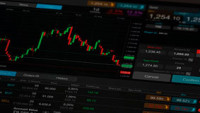 Markets in Asia have taken another leg lower this morning after reports that one of Ukraine’s nuclear power stations, at Zaporizhzhia had caught fire after being shelled by Russian forces.
Markets in Asia have taken another leg lower this morning after reports that one of Ukraine’s nuclear power stations, at Zaporizhzhia had caught fire after being shelled by Russian forces.
Putting to one side that it takes a special kind of stupid to start firing on a nuclear power station, it’s doubly incomprehensible and reckless given Russia’s experience with Chernobyl nearby, and the potential impacts on Russia itself, as well as Europe, from any potential fallout.
The environmental damage in that region alone has rendered the agricultural land there unusable for years, and further damage from another nuclear meltdown would be catastrophic. Early reports suggest the fire is under control but as an indication of the lengths Russia will go to achieve its goals, it’s an even more worrying development, sending wheat and corn prices soaring.
Early indications suggest that the fire hasn’t damaged essential equipment, is now out, and that there are currently no changes in radiation levels.
Because of this new development, its set to be another lousy start for European markets as we look to another big week of losses for the German DAX, with the index set to open at a fresh one year low. The FTSE100 is also set to see another big plunge after falling over 2.5% yesterday, as we look to open close to the December lows.
US markets on the other hand have been holding up better this week, although they finished largely in the red yesterday and also look set to open lower later this afternoon.
The tightening of the sanctions ratchets this week, while proving to be effective on inflicting economic damage on Russia, is also likely to inflict significant economic damage on Europe as well, given its much heavier reliance on Russian gas imports.
As we look to today’s European open further weakness looks increasingly likely, as the price of Russia’s actions in Ukraine make themselves felt on an economic, as well as a humanitarian basis in eastern Europe.
It could very well be argued that today’s US payrolls report is largely meaningless when it comes to what the Federal Reserve is likely to do when it meets in just under two weeks’ time. We’ve already heard from Fed chairman Jay Powell this week that a 0.25% increase in the Fed funds rate is appropriate, and while there has been chatter that FOMC members might be tempted to lean towards a 50bps move it’s hard to imagine a scenario where a majority of the committee might be tempted to go for that in the current environment.
Having said that a week is a long time in financial markets, and while Russia’s invasion of Ukraine has darkened the outlook for economic growth, the picture for inflation is even worse as energy and agricultural commodity prices have soared in the past few days. Yesterday Brent crude prices hit their highest levels since 2012 above $120 a barrel before retreating, and wheat prices their highest levels since 2008.
If the current environment prevails, things are unlikely to improve, which means that anything short of a ceasefire could see prices head even higher from where they are now.
Yesterday PPI in Europe hit another record high of 30.6% on an annualized basis and by 5.2% in January alone, which suggests further upside for CPI in the coming months.
Nonetheless, on the bright side of the ledger the jobs market still appears to be holding up well even if people are becoming poorer in real terms, which brings us to today’s US jobs report.
Earlier this week the February ADP payrolls report saw 475k new jobs added to the US economy, however that wasn’t the real headline. That came with the January revision from -301k to 509k, and 810k swing from negative to positive, bringing it into line with the January BLS report.
Putting to one side how it’s even possible to see that kind of huge revision it should be noted we’ve seen some sizeable revisions in the BLS data as well.
In the leadup to last month’s January jobs report there was a lot of briefing about the prospect of a disappointing number, by both the Federal Reserve, as well as US government officials.
It was therefore a big surprise when the resulting numbers not only confounded expectations, but also saw large upward revisions to November and December as well. From the various revisions we’ve seen in a lot of the data it would appear that the Omicron variant has prompted quite a lot of fluidity in the overall numbers.
In any case January saw a big jump in hiring to 467k, well above expectations of 125k, while the December number was revised higher from 199k to 510k, as the US economy added over 900k new jobs over the Christmas and New Year period.
Despite all the concerns about a big hit to hospitality and retail due to Covid absences, food and drinking places saw job gains of 108k, while retail trade saw 61.1k new jobs added, which doesn’t quite tally with the big jumps that we’ve been seeing in the weekly jobless claims’ numbers over the Christmas and New Year period.
Nonetheless expectations are for another strong number of an average of 415k jobs to be added in February, although this could come in as low as 80k at the bottom of the median, and 725k at the top. Wherever the number comes in, its not likely to alter the calculus for a March rate rise.
With the jobs market looking much better than initially feared, the wages data has also been much better rising to 5.7% in January, and is expected to continue to move higher, to 5.8%, and potentially higher, given that there are over 11m vacancies in the US economy.
Another positive development from January saw the participation rate rise sharply to 62.2%, a decent jump from 61.9%, and the highest level since March 2020, but still well below the 63.4% it was in February 2020. This improvement needs to be sustained to keep the Fed on course for further rate rises beyond March.
EUR/USD – broken below the 1.1100 area, thus opening up a move towards 1.0980, and levels last seen in May 2020. Hard to see much in the way of upside for euro at the moment while below 1.1240.
GBP/USD – currently struggling to rally beyond the 1.3450 area, and while below the bias remains for further losses towards 1.3260, and then the December lows of 1.3160.
EUR/GBP – has slipped to its lowest level since June 2016 and looks set to fall further towards 0.8000. Resistance still remains back near the 0.8410/20 area, and while below further weakness seems likely.
USD/JPY – still has resistance at the 115.80 area, a break of which retargets the 116.50 area. We still have support at the 114.40/50 area.












